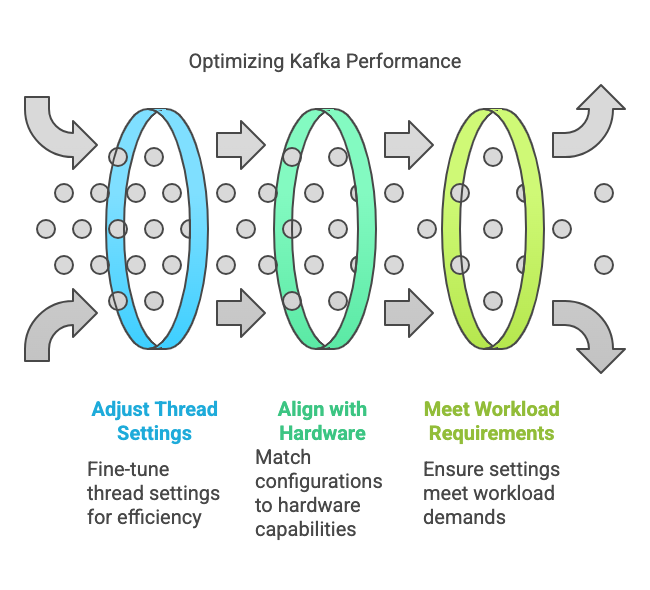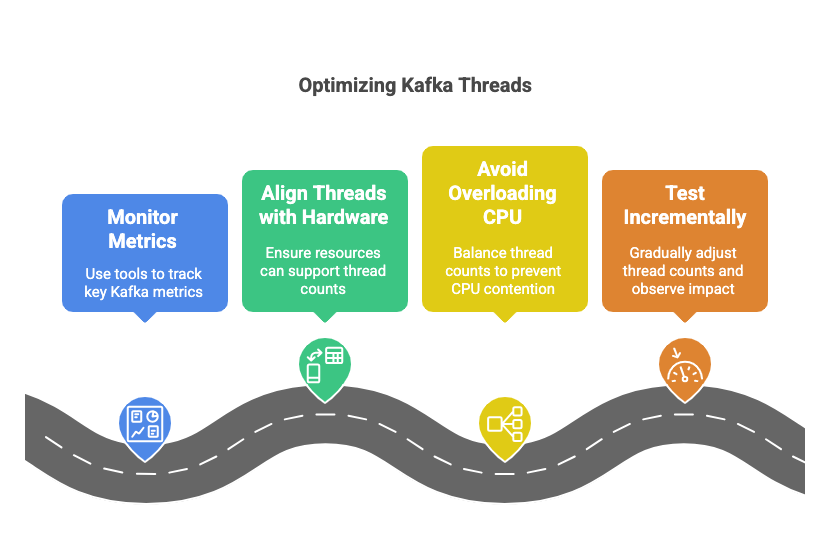Apache Kafka is the backbone of modern data streaming architectures. Optimizing Kafka threads is crucial for achieving Kafka efficiency. To maximize Kafka optimization and ensure seamless performance, fine-tuning critical configurations—network threads, I/O threads, and background threads—is essential.
This blog dives into three critical Kafka broker configurations: num.network.threads, num.io.threads, and background.threads.
We’ll explore what they do, why they matter, and how you can optimize them to suit your workload.
By the end, you’ll have a solid understanding of how these settings impact Kafka’s performance and reliability.
The Importance of Kafka Configuration Properties and Best Practices for Kafka Optimization
Kafka is designed to scale and perform under demanding workloads, handling millions of messages per second. However, its performance hinges on how well you configure the broker settings. Kafka optimization ensures network threads, I/O threads, and background threads function effectively.
Thread-related configurations like num.network.threads, num.io.threads, and background.threads control how Kafka manages resources for handling network requests, disk I/O, and background maintenance tasks. Misconfigured threads can lead to bottlenecks, underutilized hardware, or even cluster instability.
By tuning these properties, you align Kafka's operations with your hardware and workload requirements, ensuring optimal throughput, low latency, and seamless cluster operation.

Deep Dive into Kafka Optimization: Network, I/O, and Background Threads
1. num.network.threads
- Definition: The number of threads dedicated to handling network requests from producers, consumers, and other Kafka clients.
- What It Does:
Kafka relies on these threads to process requests such as message production, message fetching, and metadata updates. Each client connection is assigned a thread from this pool, making it a key setting for managing concurrent client traffic. - Default Value:
3 - When to Adjust:
- If you have hundreds or thousands of producers and consumers connecting to the broker, the default value may not suffice.
- High
network.request-rateorrequest.queue.sizemetrics in monitoring tools indicate the need for more threads.
- Best Practices for Kafka Optimization:
- Match the thread count to the expected number of concurrent connections. For instance, if your broker handles 500 clients simultaneously, increasing this to 8-10 threads might be ideal.
- Avoid over-allocating threads, as this can lead to CPU contention, especially on hardware with limited cores.
2. num.io.threads
- Definition: Specifies the number of threads used for disk I/O operations, such as reading and writing log segments.
- What It Does:
Kafka stores messages in log files on disk for durability and high throughput. These threads are responsible for reading messages for consumers, writing incoming messages, and performing file system operations like segment rotation. - Default Value:
8 - When to Adjust:
- If your Kafka broker is disk I/O bound, increasing this property can reduce latency and improve throughput.
- Monitor disk-related metrics such as
log.flush-rateor storage throughput. If you notice a bottleneck, it’s time to consider raising the value.
- Best Practices for Kafka Optimization:
- Align the value with the number of physical disks used by the broker. For instance, if you use a RAID 10 setup with four physical disks, set
num.io.threads=4or higher. - Use high-performance disks (e.g., SSDs) to complement increased thread counts.
- Avoid values much higher than the number of CPU cores, as excessive I/O threads may lead to CPU oversubscription.
- Align the value with the number of physical disks used by the broker. For instance, if you use a RAID 10 setup with four physical disks, set
3. background.threads
- Definition: The number of threads dedicated to Kafka's housekeeping tasks, such as log segment cleanup and deletion.
- What It Does:
Kafka performs various background operations to maintain log durability and cleanliness. Tasks like log compaction, segment deletion, and quota enforcement depend on these threads. - Default Value:
10 - When to Adjust:
- If log cleanup tasks are delayed or if log compaction processes fall behind, consider increasing this value.
- Monitor metrics like
log.cleanup.time.msandlog.segment.delete.delay.msto determine if more threads are needed.
- Best Practices for Kafka Optimization:
- Match the value to your cluster’s log retention and compaction settings. For clusters with frequent compaction tasks, increase the thread count.
- Ensure other thread pools (e.g.,
num.network.threads) are sufficiently configured to avoid competition for CPU resources.
Configuring Kafka Properties
To update these properties, modify your server.properties file:
In environments using configuration management tools (e.g., Ansible, Terraform), properties are often templated:
Be sure to replace variables like {{ kafka_num_network_threads }} with appropriate values based on your workload and monitoring insights.
Optimize Kafka Threads for Maximum Efficiency:
- Monitor Metrics Continuously:
Use tools like Datadog, Prometheus, or Grafana to monitor Kafka metrics. Key metrics include:network.request-rate(for network threads)disk.flush-rate(for I/O threads)log.cleanup.time.ms(for background threads)
- Align Threads with Hardware:
Ensure your CPU, memory, and disk resources can handle the thread counts you configure. - Avoid Overloading CPU:
While increasing thread counts can improve performance, it can also lead to CPU contention. Strike a balance based on available cores. - Test Incrementally:
Increase thread counts gradually and observe the impact before making further adjustments.

Conclusion
Thread configurations—num.network.threads, num.io.threads, and background.threads—play a pivotal role in optimizing Kafka’s performance. By understanding what these properties do and fine-tuning them, you can ensure your Kafka cluster meets the demands of even the most demanding workloads. By following these tips, you’ll master Kafka optimization and achieve better performance.
Always monitor your cluster, align thread counts with your hardware, and test configurations incrementally to achieve the best results. With proper tuning, Kafka can deliver the high throughput, low latency, and reliability your applications need.
FAQs
Q1. What happens if I set too many threads?
Excessive threads can lead to CPU contention, reducing overall cluster performance. Always balance thread counts with hardware capacity.
Q2. Are the default values sufficient for most use cases?
Defaults work well for small-scale deployments, but larger clusters often require adjustments to handle higher loads.
Q3. How do I know if I need more background.threads?
Monitor metrics like log.cleanup.time.ms and log.segment.delete.delay.ms. If background tasks are delayed, increase the thread count.
With these tips and configurations, you’re well-equipped to optimize Kafka for maximum performance and reliability.




